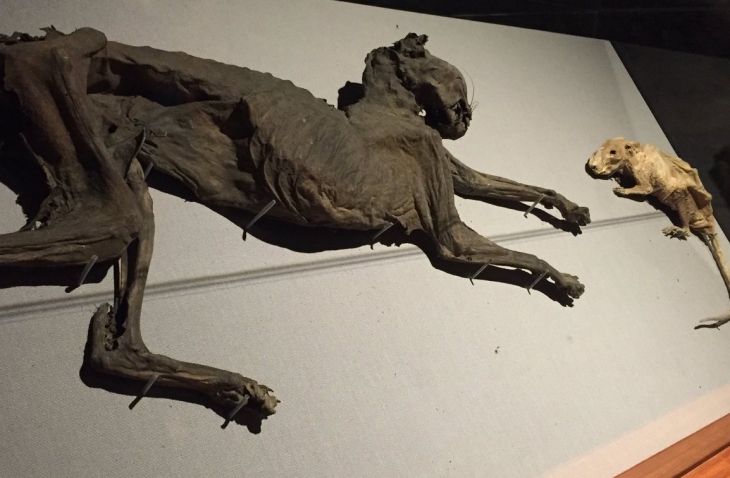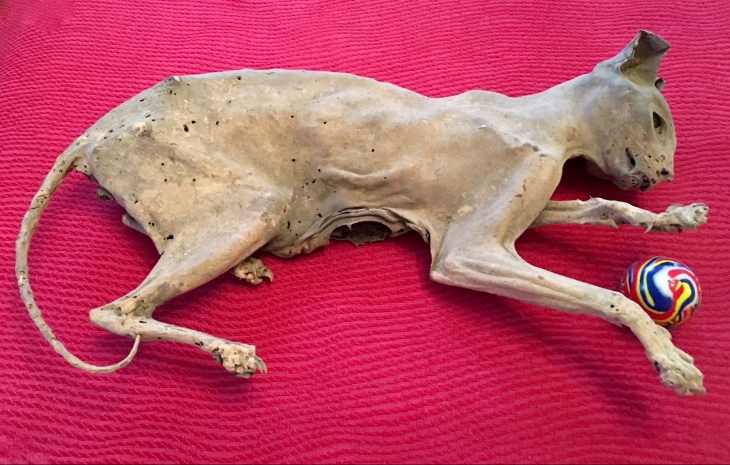We already had four cats when we found Mortimer. We didn’t want another cat.
But when Mortimer’s owners unexpectedly discovered him, trapped beneath the floorboards of a century-old home they were renovating, they didn’t want him either. Instead, they handed him over to a hesitant shop owner who thought she might be able to find him a new owner. But now the shop was closing and the customers who scurried about—hastily grabbing all manners of antiques, novelties, and tchotchkes at fifty to seventy-five percent off—had no desire to re-home Mortimer. They either avoided him all together or stood within eyesight, but not too close, whispering, “Who would take that thing home?”
Which made us feel bad for him.
So despite our initial misgivings, we decided to give Mortimer a new home. We quietly talked to a chubby little lady at the counter who was clad in stretch pants and an applique sweatshirt flocked with gingham-yellow flowers. The lady seemed shocked that we would want the cat, but she dutifully fetched a key, unlocked his case, and ever so gently—with a not-so-slight look of disgust on her face—placed him in some old newspaper and wrapped him up for the ride home.
We paid $8 for Mortimer. As we carried him to the car, people stared and nudged each other. We were now the proud owners of a mummified cat.

Before we found Mortimer, I had read about desiccated cats sealed up in old buildings to ward off evil spirits and witches. In Ireland a few years back, we had even stumbled across a mummified cat displayed in the crypt of Dublin’s Christ Church Cathedral. According to lore, the cat—more aptly dried than mummified—had chased a rat into a pipe of the cathedral’s organ, “expiring,” as the Brits like to say, until he and his rodent companion were re-discovered in the 1850s. The Christ Church cat had even gained a degree of notoriety when James Joyce described a character in Finnegan’s Wake as being, “as stuck as that cat to that mouse in that tube of that Christ Church organ.” Today, they are displayed behind glass for visitors to gawk at and take selfies with.
We figured Mortimer deserved that same level of respect. But we also wanted to get a grip on the folklore vs. the facts around the phenomenon of dried cats. Were they truly purposeful harbingers of good luck who staved off evil—or like the Christ Church cat, were they unfortunate victims who wandered into the wrong space and never found a way out? And if the cats were indeed purposeful, were they dead before they were concealed? Or were they killed for the express purpose of being immured in the walls? Or worse yet, were they walled in alive à la Edgar Allan Poe’s Cask of Amontillado.
Believe it or not, there are historians who research these things. In 1951, Margaret Howard pioneered a study of concealed cats in the United Kingdom. In 2010, Ian Evans penned a doctoral thesis that broadened the study of cat and other concealment rituals to Australia. More recently, M. Chris Manning examined the phenomenon in the US.
These researchers uncovered hundreds of documented concealed cats. Described as desiccated, ossified, preserved, mummified, dried, or even smoked, the condition of the cats indicated that the concealments were deliberate. In many cases, the cats were posed as if stalking—some with dried mice or rats staged in their mouths. Other cats were found in specially carved crevices crafted to house the defunct felines. And although the media has shared sensationalized stories about animals who were supposedly walled in alive, physical evidence shows that concealments were traditionally postmortem.

And not only cats were ritually sealed up in buildings. Other animals, even dogs, were concealed. In Ireland, horse skulls were embedded in foundations or buried beneath thresh holds and hearthstones. 19th-century records show that in Transylvania, in addition to animal bones, a human bone was often buried in the floor to ensure the stability of a building. And objects, particularly shoes and “witch bottles,” were frequently concealed with the intent to ward off bad spirits.

In this modern era, tales of dried cats often catch the media’s attention. In 2009, The Telegraph reported on a 400-year-old dried cat that was unearthed during renovations to a home in Devon. The owner of the home, ironically a funeral director, shared his story. “The builders were stripping one of the bathrooms upstairs and this little fellow came to light. It is quite scary looking.” When asked about the fate of the cat, he replied, “I cannot throw it away so we plan to put it back on completion of the building work … Apparently 400 years ago people put cats behind walls to ward off witches. It clearly works as, since we have lived in the village, we have not seen sight or sound of any witches.”
Well that’s reassuring.

Other modern tales of dried cat discoveries include a crimson-hued feline found at the Red Cat Hotel in Norfolk, UK. The 1898 pub’s namesake is proudly displayed alongside a modern-day x-ray of the not-so-frisky feline. Across the pond in the 1950s, the Fargo Forum reported on a dried cat uncovered in the wall of a buggy shed in Moorhead, Minnesota. She was positioned with a mouse clenched in her teeth and a page from an 1876 newspaper, which predated the construction of the shed. In 1948, the Charlotte News reported the discovery of a dried cat that had been deposited in a plaster & lathe wall of an 1800s house. The cat was standing on all fours—poised to to pounce on a dried rat positioned at his feet (Manning).
As early as 1914, the Encyclopædia of Religion and Ethics connected cat concealment with the ancient belief that a new building must have a victim to ensure the safety of its inhabitants. The voluminous tome recounts a legend in which the devil builds a bridge, but in return, demands the soul of the first being to cross the completed structure. Of course the townsfolk outwit the devil by sending a cat across the bridge. Similarly, 18th-century Prussians would fling a cat into a new home before any human entered the building. In Lierge, Belgium, it was customary for a cat to be shut up in a new house and allowed to die of hunger before any man, woman, or child entered the abode. Such practices were found all over Europe and the superstitions that inspired them traveled with immigrant families to America.

Belief in the power of concealed cats wasn’t limited to superstitious peasantry. The French romantic writer François-René de Chateaubriand was a great lover of cats (his favorite cat, Micetto, had once belonged to Pope Leo XII). In Mémoires d’Outre-Tombe, Chateaubriand regales readers with tales of the ghosts who haunted the medieval fortress of Combourg, where he spent much of his unhappy youth. One spectre, the ghost of Count Malo de Coëtquen, who had lost a leg at the Battle of Malplaquet in 1709, would wail through the corridors, his wooden leg clomping along the floor, followed by his moaning black cat. A century later, Chateaubriand’s grand-nephew, while restoring the castle, found a dried black cat deep in the castle walls. Did Chateaubriand conceal the cat to scare away Coëtquen’s spirit? We’ll never know for sure, but today, the cat is displayed in Chateaubriand’s room, his mouth wide open, prepared to attack any vermin or evil spirit who might dare invade its castle.

But back to Mortimer. What’s his story? Who was he protecting—and from what?
Honestly, we don’t know what house or building Mortimer was found in. We don’t know anything about him—and we’re the ones who gave him the name Mortimer. (Get it??)

We will never know if Mortimer was concealed on purpose or if he met an untimely demise as a byproduct of his overzealous curiosity, like the Christ Church cat. But we were determined to give him a good home—especially after learning that he is more likely to bring us good luck rather than harm. Though our other cats were a bit wary at first, they now confidently prance past the curio case in which he resides, never batting a whisker. And while the four of them might prefer to take the credit, we feel compelled to note that since Mortimer’s arrival, neither a mouse nor a witch have been sighted at our 100-year-old house or within the nearby village.